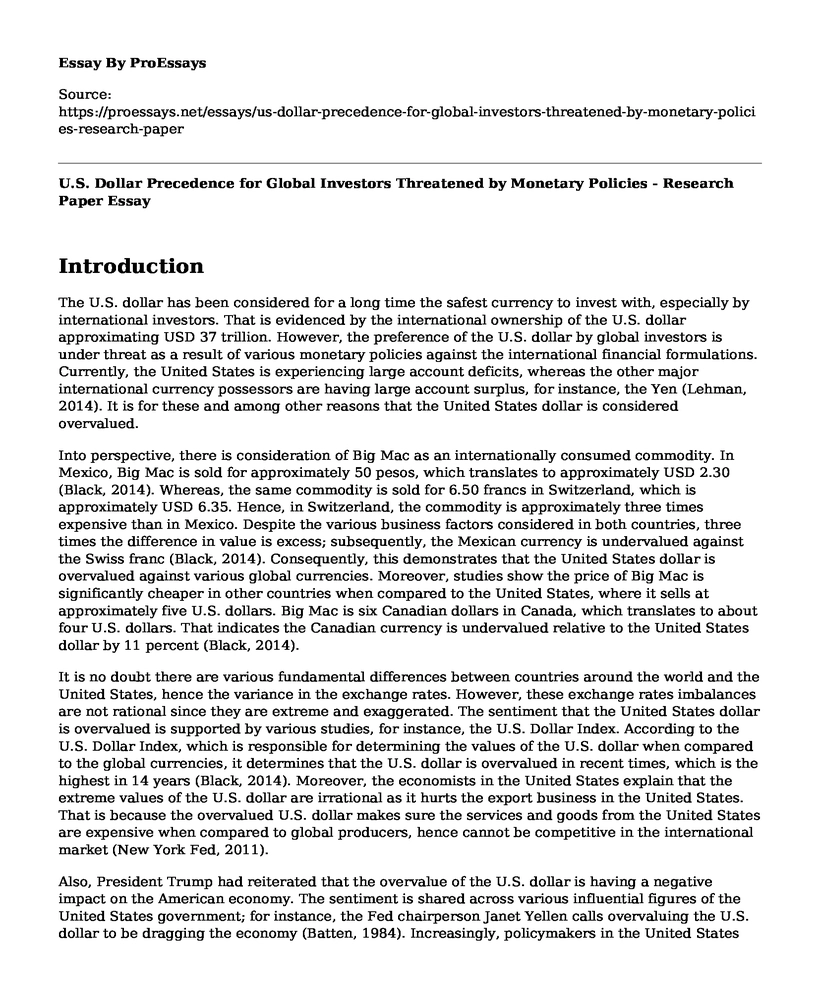Introduction
The U.S. dollar has been considered for a long time the safest currency to invest with, especially by international investors. That is evidenced by the international ownership of the U.S. dollar approximating USD 37 trillion. However, the preference of the U.S. dollar by global investors is under threat as a result of various monetary policies against the international financial formulations. Currently, the United States is experiencing large account deficits, whereas the other major international currency possessors are having large account surplus, for instance, the Yen (Lehman, 2014). It is for these and among other reasons that the United States dollar is considered overvalued.
Into perspective, there is consideration of Big Mac as an internationally consumed commodity. In Mexico, Big Mac is sold for approximately 50 pesos, which translates to approximately USD 2.30 (Black, 2014). Whereas, the same commodity is sold for 6.50 francs in Switzerland, which is approximately USD 6.35. Hence, in Switzerland, the commodity is approximately three times expensive than in Mexico. Despite the various business factors considered in both countries, three times the difference in value is excess; subsequently, the Mexican currency is undervalued against the Swiss franc (Black, 2014). Consequently, this demonstrates that the United States dollar is overvalued against various global currencies. Moreover, studies show the price of Big Mac is significantly cheaper in other countries when compared to the United States, where it sells at approximately five U.S. dollars. Big Mac is six Canadian dollars in Canada, which translates to about four U.S. dollars. That indicates the Canadian currency is undervalued relative to the United States dollar by 11 percent (Black, 2014).
It is no doubt there are various fundamental differences between countries around the world and the United States, hence the variance in the exchange rates. However, these exchange rates imbalances are not rational since they are extreme and exaggerated. The sentiment that the United States dollar is overvalued is supported by various studies, for instance, the U.S. Dollar Index. According to the U.S. Dollar Index, which is responsible for determining the values of the U.S. dollar when compared to the global currencies, it determines that the U.S. dollar is overvalued in recent times, which is the highest in 14 years (Black, 2014). Moreover, the economists in the United States explain that the extreme values of the U.S. dollar are irrational as it hurts the export business in the United States. That is because the overvalued U.S. dollar makes sure the services and goods from the United States are expensive when compared to global producers, hence cannot be competitive in the international market (New York Fed, 2011).
Also, President Trump had reiterated that the overvalue of the U.S. dollar is having a negative impact on the American economy. The sentiment is shared across various influential figures of the United States government; for instance, the Fed chairperson Janet Yellen calls overvaluing the U.S. dollar to be dragging the economy (Batten, 1984). Increasingly, policymakers in the United States want efforts to be put to ensure the dollar is lowered to competitive rates.
Conclusion
The following evidence has done well to support the claim that the U.S. dollar is overvalued to the extent that it is not rational. Thus, prompting the United States government and the Federal Reserve to adopt measure making sure the U.S. dollar acquires a competitive value. There has also been a demonstration of how foreign currencies are significantly undervalued in relation to the U.S. dollar.
References
Batten, D. (1984). What Can Central Banks Do About the Value of the Dollar? https://files.stlouisfed.org/research/publications/review/84/05/Central_May1984.pdf
Black, S. (2014). The U.S. dollar is now overvalued against almost every currency in the world | Sovereign Man. https://www.sovereignman.com/investing/the-us-dollar-is-now-overvalued-against-almost-every-currency-in-the-world-20704/
Lehman, L. (2014). The Federal Reserve and the Dollar. https://pdfs.semanticscholar.org/a424/cffc8897cfc7174fbee2d6ed35fa1d457211.pdf
New York Fed. (2011). Currency Devaluation and Revaluation - FEDERAL RESERVE BANK of NEW YORK. https://www.newyorkfed.org/aboutthefed/fedpoint/fed38.html
Cite this page
U.S. Dollar Precedence for Global Investors Threatened by Monetary Policies - Research Paper. (2023, Mar 09). Retrieved from https://proessays.net/essays/us-dollar-precedence-for-global-investors-threatened-by-monetary-policies-research-paper
If you are the original author of this essay and no longer wish to have it published on the ProEssays website, please click below to request its removal:
- Movements by Native Americans Essay
- Argumentative Essay on Social Media Policies in Colleges
- The Universal Design for Learning Approach Paper Example
- Paper Example on Windsor Family Financial Plan: Alastair & Wendy's Secure Future
- Essay Example on Modern Policing: Adapting to New Technology & Community Objectives
- Essay Example on Plato's Blueprint for Democracy: Aristocracy for Tyranny Prevention
- Paper Example on Unraveling Fraud in Banking: A Case Study of Kweku Adoboli's Illegal Trading at UBS







